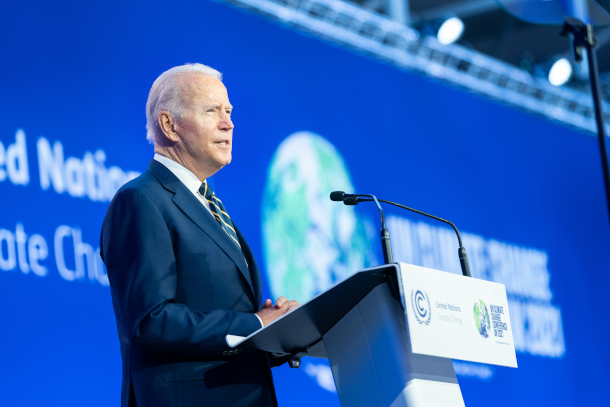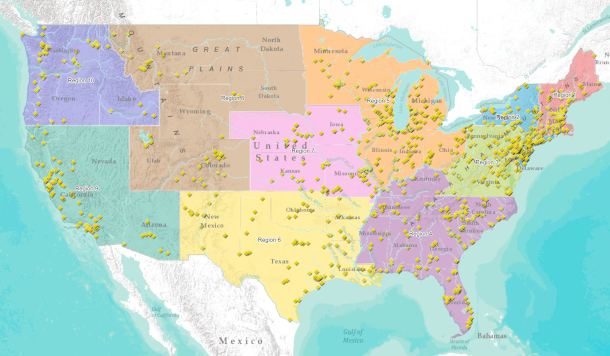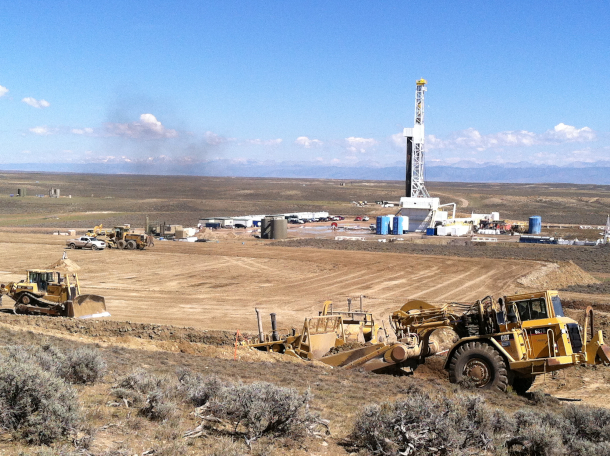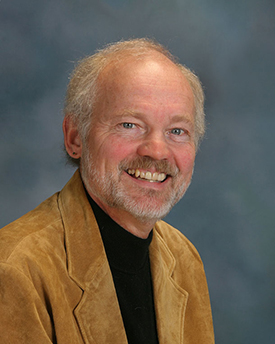President Biden’s First Year
Air Date: Week of January 21, 2022

President Biden speaks at COP26 in Glasgow, Scotland in November 2021. (Photo: The White House)
Since President Biden took office a year ago his administration has emphasized the importance of addressing the climate crisis, arguably more so than any other in US history. Biden’s goals included halting federal oil and gas drilling, reaching carbon neutrality by 2050, and rectifying environmental injustices. Vermont Law School Professor Pat Parenteau joins Host Steve Curwood to discuss to what extent those words have translated into action and where more progress can be made.
Transcript
CURWOOD: It’s Living on Earth, I’m Steve Curwood.
A year ago Democratic President Joe Biden took office and dramatically changed the rhetoric on the environment from the previous Republican Administration.
BIDEN: We're standing at an inflection point in world history. We have the ability to invest in ourselves and build an equitable, clean energy future, and in the process, create millions of good paying jobs and opportunities around the world, cleaner air for our children, where bountiful oceans, healthier for us and ecosystems for our planet.
CURWOOD: Since his inauguration President Joe Biden has accomplished some firsts for conservation and the environment. He appointed the first Native Americans ever to run the Interior Department and National Park Service, in efforts to redress the trail of broken treaties and land expropriation that haunt US history. He is also the first president to restore more than 100,000 acres of National Monument designations in Indian country that had been rolled back by his predecessor. And Mr. Biden is the first president to set up a White House council on environmental justice. History will note his bold plans to address climate change. His goals include that at least half of all new cars be electric by 2030 and that the nation become carbon neutral by 2050. He also immediately rejoined the Paris Climate Agreement. But in the remaining 3 years of his term Joe Biden has much still to do, as a divided Congress has trimmed or blocked much of the spending he wants for climate and environmental protection. And he faces a rocky road when it comes to executive orders and regulations since the Republican dominated Supreme Court is likely to oppose any orders or rules that rely on flexible interpretations of laws. Joining us now for more is Vermont Law School Professor Pat Parenteau. Welcome back to Living on Earth Pat!
PARENTEAU: Thanks very much, Steve, good to be with you.
CURWOOD: So what are some of the more immediate actions that Biden took during his first few months in the presidency? I'm thinking about a series of executive orders that he reversed, he got turned around.
PARENTEAU: Right. So day one, he signed a series of executive orders, one of which committed the nation to addressing the climate crisis, rejoining the Paris Agreement, delegating the authority to Senator John Kerry, and Secretary of State John Kerry, as the climate envoy to the world. And Kerry has been negotiating with China, for example, on some major attempts to reduce emissions. He's appointed Gina McCarthy as the sort of climate Czarina for domestic policy to make sure that all of the agencies of government are working in coordination and all pointing in the same direction. And just interestingly enough, there's been a lot of controversy over the reappointment of Jerome Powell to the Federal Reserve Board, but here he is in his confirmation hearing, and one of the things he says right out of the box was climate change is going to be a priority for the Federal Reserve that he recognizes the threat that climate disruption is posing to the American financial system. So we're really seeing for the first time in history an all of government approach to the climate crisis.

There are more than 1,300 Superfund sites on the EPA’s National Priorities List. Yellow diamonds denote current NPL sites (Image: Screenshot of the EPA’s National Priorities superfund Map)
CURWOOD: So now in his first year in office, what has Joe Biden done in terms of managing public lands?
PARENTEAU: We've certainly seen a recommitment to designating national monuments like bears, ears, and others. But in terms of moving us away from using the public lands as a source of coal and oil and gas and moving them more into the category of the lands that we need to preserve the landscapes and the resilience and the biodiversity of the country, we're really not seeing that much movement in that area yet.
CURWOOD: Now, as I understand it, days after the climate talks in Glasgow, when the by Biden administration auctioned off approximately 80 million acres in the Gulf of Mexico for offshore drilling, they were doing this in response to a court order. How correct is that?
PARENTEAU: Well, it's partially correct. That's another curious, frankly, decision by the administration. A Trump appointee, a federal district judge in Louisiana, did rule that the administration didn't have the authority to put a temporary halt on oil and gas leasing not only in the Gulf, but this judge said everywhere in the United States, including public lands in the West. And so the Biden administration has appealed that ruling, but they didn't request the court to stay the effect of the district court judge's opinion, which is a standard procedure when you disagree with the court. So the administration, instead of getting a stay of that order, has decided to comply with it by scheduling the first oil and gas leasing in the Gulf that we've seen since the Trump administration. But we're not seeing Biden following through on his promise to end oil and gas leasing on federal lands and waters yet. Not seeing that, at this point.
CURWOOD: Pat, the Biden administration has promised to address environmental justice with a whole of government approach. And of course, there's no lack of environmental justice issues in this country. I mean, we've got Superfund sites located in black and brown and poor communities. We've got water pollution, lead pipes in particular. I mean, to what extent have those plans, those promises, been realized? To what extent are they being executed?

Fracking on public lands in Wyoming. According to a 2021 report by the Bureau of Land Management, greenhouse gas emissions from federal oil and gas leasing were about 1 billion metric tons annually, about one-fifth of U.S. energy-related emissions. (Photo: Public Earth Guardians, Flickr, CC BY NC ND 2.0)
PARENTEAU: I think the Biden administration gets credit for prioritizing environmental justice in various areas. EPA, under Title six of the Civil Rights Act of 1964 has both the authority and the obligation to make sure that when new facilities are being cited, particularly polluting facilities, you know, like power plants, like oil refineries, make sure that they're not being located in communities that have been disproportionately affected by air and water pollution. And I do see that EPA is beefing up its environmental justice office, it's giving it more priority and more sort of high visibility. What we haven't seen yet is has EPA actually acted on that authority and prohibited some of these new facilities that are being constructed? Or on the other hand, have they really stepped up the enforcement of environmental air and water quality laws in particular, to address the disproportionate impacts? I think we have to give the administration some time to do this. But I'm looking to see some more tangible evidence on the ground in these communities, that the commitment to environmental justice is real, but they need more tools, they need more, the administration needs a better mechanism to get this money out the door and into the communities that need it faster, and to make sure that the investments that are being made are actually accomplishing, right, the goals that the administration has for addressing these problems. I think the environmental justice community has been very patient so far, but I'm sensing Robert Bullard just gave a major address. He is the father of environmental justice in this country. He just gave a major address. He's on the President's Environmental Justice Taskforce, in which he said, you know, it's time to see some tangible results from these commitments. So that's what we're all waiting for now.
CURWOOD: So the bipartisan infrastructure bill that was signed into law back in November, and of course, the separate bill, the Build Back Better Bill, which is still pending--to what extent did this legislation really address climate disruption? I mean, how much of an impact would we see if both bills go into action, and what's the impact if the second one, if Build Back Better, never really gets done?
PARENTEAU: Right. If they both go into effect, and particularly Build Back Better, if those two bills both were enacted, and that money, guys, I say, got out the door and got to the places it needs, and really accelerated the transition to clean energy and clean transportation, that would be the biggest single movement of the federal government on climate ever. So it would be historic, there's no question about it. It's also true to say it wouldn't be enough. So you know, the Build Back Better Bill, which is, you know, currently at something like 1.8, or 1.7 trillion. That sounds like a lot of money, right? But the estimate is for a real transition to a carbon free economy, now I'm talking about across the board, and I'm talking globally, the estimate is you're going to need something on the order of $5 trillion a year, starting now, and continuing right on until about 2050. So the job ahead of us, is truly unprecedented. But getting the Build Back Better bill enacted is an absolutely essential piece of President Biden's climate agenda.
CURWOOD: I want to go back to environmental justice for a moment. So even with the first infrastructure bill that was signed into law, there's money, I think there's close to $20 billion dollars, for example, to deal with lead pipes. But what about the infrastructure for the infrastructure? In other words, what mechanisms has the Biden administration put in place so that communities can apply, get the qualified designers and engineers and social folks involved to actually apply for this money and then use it in an effective way?
PARENTEAU: Yeah. So that's what Robert Bullard is, one of the things he's most concerned about. And that is that the administration had promised that by now, there would be this thing called a screening tool, which would identify the communities that were eligible for this sort of earmark funding, but also identify how the funds were going to be dispersed. In other words, as usual, with federal money, there's all these strings attached and all these procedures, and this paperwork, and it takes time. So that hasn't happened, you know, its execution, its follow through. That's what's important. So lots and lots of very fine grain details need to be focused on right now.

Present Biden has set a target for electric vehicles (EVs) to make up 50% of car sales in the United States by 2050. According to the International Council on Clean transportation (ICCT) that would require an increase from 216,000 chargers nationwide in 2020 to 2.4 million by 2030. (Photo: JCT600, Flickr, CC BY SA 2.0)
CURWOOD: Spoiler alert, this Build Back Better Bill that's wrapped up in the so called reconciliation mechanism, may not actually get passed, in that form. So what is the Biden administration do to keep pressing on climate, if they don't get the big bill through?
PARENTEAU: What the administration has been saying, and this would be people like Gina McCarthy, is that they will make full use of all the authorities that they have, including things like regulating the oil and gas industry for methane emissions, including things like increasing fuel economy standards to 40 miles per gallon by model year 2023, including things like regulating some of these ozone depleting chemicals, these hydrofluorocarbons, which are massive greenhouse gas accelerators, and they are moving forward very aggressively on that. We just saw an announcement that they're going to crack down on the cleanup of these awful coal ash facilities, which are all over coal country. And EPA has also announced they're going to tighten the toxic effluent limits from coal-fired power plants. So, you know, Biden is going to make full use of all of his executive branch authority, including reversing all of Trump's anti-environmental rules, which is, you know, that's another undertaking that requires careful preparation of the record to support what you're doing, because it's going to be challenged in court, by the Red State Attorney General's, who've challenged everything that Biden has been proposing, so far, we can count on them continuing to do that, plus the coal industry and the fossil fuel industry. So, you know, this is what the Biden administration is looking at for the rest of their term. If they don't get meaningful action from Congress, it's going to be a guerrilla warfare, it's going to be fighting rule by rule, decision by decision. And that's really not going to move us very fast and very far towards where we need to go. We desperately need some legislation from Congress.
CURWOOD: Pat, the climate crisis, of course, is an existential one, right? So what do you think the Biden administration should really focus on, in the three remaining years of this term to deal with this crisis as a nation?

Former EPA Regional Counsel Pat Parenteau teaches environmental law at Vermont Law School. (Photo: Courtesy of Vermont Law School)
PARENTEAU: It really is about energizing the financial markets. That's the conclusion I've come to. I've been looking at the difficulty of getting anything through Congress, the difficulty of getting things through the courts. And that leaves me thinking that it's the financial markets. Believe it or not, that may be the salvation. You know, Jerome Powell said, he's going to seriously consider requiring that banks stress test their portfolios, meaning look at how much of their loans is based on fossil fuels, and have the banks taken into account the risk of stranded assets, the fact that the collateral that's being pledged for these multi-billion dollar loans is not worth the paper it's written on. And the analog for this, of course, is the housing bubble. And what happened when that collapsed? And what happened to banks and brokerage firms, when that happened? And we are seeing from the financial institutions a growing awareness and concern about the risks, the financial risks from climate. So if we could get some combination of either state, and hopefully federal policies, including some investments, including using tax money to leverage private investment. For example, Connecticut has a green bank. And it's been very successful. It's small scale in comparison to what's needed, but it's been very successful in leveraging state money to get private money at a ratio of eight to one. So for every $1 of public money, you get $8 of private capital. And it is being directed by the way in Connecticut, to environmental justice communities, for energy investments, solar and wind, for example. So that, to me looks like the model for the future: a combination of kind of strategic governmental policies and investments, coupled with the private capital, moving more aggressively into the clean energy, clean transportation field. That may be our only real hope of accelerating the transition that we need.
CURWOOD: Pat Parenteau's a former regional council for the Environmental Protection Agency, and a professor at the Vermont Law School. Pat, thanks so much for taking the time with us today.
PARENTEAU: You bet Steve. Always a pleasure.
Links
PBS News Hour | “Biden speaks at COP26 climate summit in Glasgow”
Learn more about the White House Environmental Justice Advisory Council
Living on Earth wants to hear from you!
Living on Earth
62 Calef Highway, Suite 212
Lee, NH 03861
Telephone: 617-287-4121
E-mail: comments@loe.org
Newsletter [Click here]
Donate to Living on Earth!
Living on Earth is an independent media program and relies entirely on contributions from listeners and institutions supporting public service. Please donate now to preserve an independent environmental voice.
NewsletterLiving on Earth offers a weekly delivery of the show's rundown to your mailbox. Sign up for our newsletter today!
 Sailors For The Sea: Be the change you want to sea.
Sailors For The Sea: Be the change you want to sea.
 The Grantham Foundation for the Protection of the Environment: Committed to protecting and improving the health of the global environment.
The Grantham Foundation for the Protection of the Environment: Committed to protecting and improving the health of the global environment.
 Contribute to Living on Earth and receive, as our gift to you, an archival print of one of Mark Seth Lender's extraordinary wildlife photographs. Follow the link to see Mark's current collection of photographs.
Contribute to Living on Earth and receive, as our gift to you, an archival print of one of Mark Seth Lender's extraordinary wildlife photographs. Follow the link to see Mark's current collection of photographs.
 Buy a signed copy of Mark Seth Lender's book Smeagull the Seagull & support Living on Earth
Buy a signed copy of Mark Seth Lender's book Smeagull the Seagull & support Living on Earth

